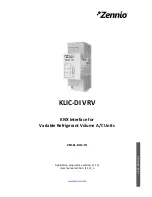
because one or more of the fundamental frequency differential currents entered the
operate region on the operate - restrain characteristic. So, this protection is not
independent of the traditional restrained differential protection - it is activated after
the first start signal has been placed.
If the fault is positively recognized as internal, then the unrestrained negative
sequence differential protection places its own trip request.
If the bias current is higher than 110% of
IBase
of the power transformer winding W1,
then any block signals by the harmonic and/or waveform blocking criteria are
overridden, and the differential protection operates quickly without any further delay.
If the bias current is lower than 110% of
IBase
, the negative sequence differential
protection is restrained by any harmonic block signal.
This logic guarantees a fast disconnection of a faulty power transformer for any heavy
faults.
If a fault is classified as external, the further analysis of the fault conditions is initiated.
If all the instantaneous differential currents in phases where start signals have been
issued are free of harmonic pollution, then a (minor) internal fault, simultaneous with
a predominant external fault can be suspected. If the differential current is above the
restrain limit a trip will be issued.
During external faults, major false differential currents can only exist when one or
more current transformers saturate. In this case, the false instantaneous differential
currents are polluted by higher harmonic components, the 2
nd
, the 5
th
and so on and the
differential protection will block the trip operation based on the blocking criteria.
Sensitive negative sequence based turn-to-turn fault protection
The sensitive, negative sequence current based turn-to-turn fault protection detects
the low level faults, which are not detected by the traditional differential protection
until they develop into more severe faults, including power transformer iron core. The
sensitive protection is independent from the traditional differential protection and is a
very good complement to it. The essential part of this sensitive protection is the
internal/external fault discriminator. In order to be activated, the sensitive protection
requires no start signal from the traditional power transformer biased differential
protection. If magnitudes of HV and LV negative sequence current contributions are
above the set limit for
IminNegSeq
, then their relative positions are determined. If the
disturbance is characterized as an internal fault, then a separate trip request will be
placed. Any decision on the way to the final trip request must be confirmed several
times in succession in order to cope with eventual CT transients. This causes a short
additional operating time delay due to this security count. For very low level turn-to-
turn faults the overall response time of this protection is about 30ms. The sensitive
negative sequence differential protection is automatically deactivated if the bias
current becomes higher than 150 %
IBase
. Further, this protection can always be
restrained by any harmonic block signal. This because at rather low fault currents,
which are to be detected by this protection, harmonic pollution is not likely.
Section 6
1MRK 504 135-UEN A
Differential protection
102
Technical manual
Содержание ret650
Страница 1: ...Relion 650 series Transformer protection RET650 Technical manual ...
Страница 2: ......
Страница 40: ...34 ...
Страница 62: ...56 ...
Страница 84: ...78 ...
Страница 208: ...202 ...
Страница 353: ...Table 236 Gray code conversion IEC06000523 V1 EN 1MRK 504 135 UEN A Section 12 Control 347 Technical manual ...
Страница 376: ...370 ...
Страница 414: ...408 ...
Страница 530: ...524 ...
Страница 562: ...556 ...
Страница 620: ...614 ...
Страница 668: ...662 ...
Страница 669: ...663 ...
















































